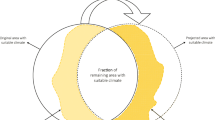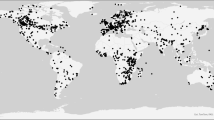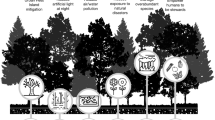Abstract
Context
Light pollution is a global change affecting a major proportion of global land surface. Although the impacts of Artificial Light At Night (ALAN) have been documented locally for many taxa, the extent of effect of ALAN at a landscape scale on biodiversity is unknown.
Objectives
We characterized the landscape-scale impacts of ALAN on 4 insectivorous bat species Pipistrellus pipistrellus, Pipistrellus kuhlii, Eptesicus serotinus, Nyctalus leisleri, and compared the extent of their effects to other major land-use pressures.
Methods
We used a French national-scale monitoring program recording bat activity among 2-km car transect surveys, and extracted landscape characteristics around transects with satellite and land cover layers. For each species, we performed multi-model averaging at 4 landscape scales (from 200 to 1000 m buffers around transects) to compare the relative effects of the average radiance, the proportion of impervious surface and the proportion of intensive agriculture.
Results
For all species, ALAN had a stronger negative effect than impervious surface at the 4 landscape scales tested. This effect was weaker than the effect of intensive agriculture. The negative effect of ALAN was significant for P. pipistrellus, P. kuhlii and E. serotinus, but not for N. leisleri. The effect of impervious surface varied among species while intensive agriculture had a significant negative effect on the 4 species.
Conclusion
Our results highlight the need to consider the impacts of ALAN on biodiversity in land-use planning and suggest that using only impervious surface as a proxy for urbanization may lead to underestimated impacts on biodiversity.




Similar content being viewed by others
References
Arthur L, Lemaire M (2009) Les Chauves-souris de France Belgique Luxembourg et Suisse. BIOTOPE
Azam C, Kerbiriou C, Vernet A, Julien JF, Bas Y, Plichard L, Maratrat J, Le Viol I (2015) Is part-night lighting an effective measure to limit the impacts of artificial lighting on bats? Global Change Biol 21:4333–4341
Barton K (2015) MuMIn: Multi-Model Inference. R package version 1.13.4. http://CRAN.R-project.org/package=MuMIn
Bates AJ, Sadler JP, Grundy D, Lowe N, Davis G, Baker D, Bridge M, Freestone R, Gardner D, Gibson C, Hemming R, Howarth S, Orridge S, Shaw M, Tams T, Young H (2014) Garden and landscape-scale correlates of moths of differing conservation status: significant effects of urbanization and habitat diversity. PLoS ONE 9:e86925. doi:10.1371/journal.pone.0086925
Bates D, Maechler M, Bolker B, Walker S (2015) Fitting linear mixed-effects models using lme4. J Stat Softw 67:1–48
Baugh K, Hsu F-C, Elvidge CD, Zhizhin M (2013) Nighttime lights compositing using the VIIRS day-night band: preliminary results. Proc Asia-Pac Adv Netw 35:70–86
Bennie J, Davies TW, Cruse D, Inger R, Gaston KJ (2015) Cascading effects of artificial light at night: resource-mediated control of herbivores in a grassland ecosystem. Philos Trans R Soc Lond B 370:20140131. doi:10.1098/rstb.2014.0131
Blake D, Hutson AM, Racey PA, Rydell J, Speakman JR (1994) Use of lamplit roads by foraging bats in southern England. J Zool 234:453–462. doi:10.1111/j.1469-7998.1994.tb04859.x
Boldogh S, Dobrosi D, Samu P (2007) The effects of the illumination of buildings on house-dwelling bats and its conservation consequences. Acta Chiropterol 9:527–534
Boughey KL, Lake IR, Haysom KA, Dolman PM (2011) Effects of landscape-scale broadleaved woodland configuration and extent on roost location for six bat species across the UK. Biol Conserv 144:2300–2310
Burnham KP, Anderson DR (2002) Model selection and multimodel inference: a practical information-theoretic approach. Springer, New York
Burt J (2006) Syrinx, Version 2.6 h. University of Washington, Seattle. http://SyrinxPC.com/
Charbonnier Y, Barbaro L, Theillout A, Jactel H (2014) Numerical and functional responses of forest bats to a major insect pest in pine plantations. PLoS One 9:e109488
Cleveland CJ, Betke M, Federico P, Frank JD, Hallam TG, Horn J, López Jr JD, McCracken GF, Medellín RA, Moreno-Valdez A, Sansone CG, Westbrook JK, Kunz TH (2006) Economic value of the pest control service provided by Brazilian free-tailed bats in south-central Texas. Front Ecol Environ 4:238–243. doi:10.1017/CBO9781107415324.004
Conrad KF, Warren MS, Fox R, Parsons MS, Woiwod IP (2006) Rapid declines of common, widespread British moths provide evidence of an insect biodiversity crisis. Biol Conserv 132:279–291
CORINE Land Cover (2006) Ministère de l’Ecologie, du Développement Durable et de l’Energie. Available at :http://www.stats.environnement.developpement-durable.gouv.fr/clc/CORINE_Land_Cover_-_Condition_Utilisation.htm
Davies TW, Coleman M, Griffith KM, Jenkins SR (2015) Night-time lighting alters the composition of marine epifaunal communities. Biol Lett 11:20150080
Da Silva A, Valcu M, Kempenaers B (2015) Light pollution alters the phenology of dawn and dusk singing in common European songbirds. Philos Trans R Soc Lond B 370:20140126
de Jong M, Ouyang JQ, Da Silva A, van Grunsven RH, Kempenaers B, Visser ME, Spoelstra K (2015) Effects of nocturnal illumination on life-history decisions and fitness in two wild songbird species. Philos Trans R Soc Lond B 370:20140128
Deguines N, Jono C, Baude M, Henry M, Julliard R, Fontaine C (2014) Large-scale trade-off between agricultural intensification and crop pollination services. Front Ecol Environ 12:212–217
Devictor V, Julliard R, Couvet D, Lee A, Jiguet F (2007) Functional homogenization effect of urbanization on bird communities. Conserv Biol 21:741–751
Donald PF, Green RE, Heath MF (2001) Agricultural intensification and the collapse of Europe’s farmland bird populations. Proc R Soc Lond B 268:25–29
Downs NC, Beaton V, Guest J, Polanski J, Robinson SL, Racey PA (2003) The effects of illuminating the roost entrance on the emergence behaviour of Pipistrellus pygmaeus. Biol Conserv 111:247–252
Downs NC, Racey PA (2006) The use by bats of habitat features in mixed farmland in Scotland. Acta Chiropterol 8:169–185
Eisenbeis G (2006) Artificial night lighting and insects: attraction of insects to streetlamps in a rural setting in Germany. In: Rich C, Longcore T (eds) Ecological consequences of artificial night lighting. Island Press, Washington, D.C., pp 281–304
Falchi F, Cinzano P, Duriscoe D, Kyba CD, Elvidge K, Baugh BA, Portnov NA, Furgoni R (2016) The new world atlas of artificial night sky brightness. Sci Adv 2(6):e1600377
Foley JA, DeFries R, Asner GP, Barford C, Bonan G, Carpenter SR, Chapin FS, Coe MT, Daily GC, Gibbs HK, Helkowski JH, Holloway T, Howard EA, Kucharik CJ, Monfreda C, Patz JA, Prentice IC, Ramankutty N, Snyder PK (2005) Global consequences of land use. Science 309:570–574
Fonderflick J, Azam C, Brochier C, Cosson E, Quékenborn D (2015) Testing the relevance of using spatial modeling to predict foraging habitat suitability around bat maternity: a case study in Mediterranean landscape. Biol Conserv 192:120–129
Forman RTT, Alexander LE (1998) Roads and their major ecological effects. Annu Rev Ecol Syst 29:207-C2
Fox J, Monette G (1992) Generalized collinearity diagnostics. J Am Stat Assoc 87:178–183
Frey-Ehrenbold A, Bontadina F, Arlettaz R, Obrist MK (2013) Landscape connectivity, habitat structure and activity of bat guilds in farmland-dominated matrices. J Appl Ecol 50:252–261. doi:10.1111/1365-2664.12034
Gaston KJ, Bennie J (2014) Demographic effects of artificial nighttime lighting on animal populations. Environ Rev 22:323–330
Gaston KJ, Davies TW, Bennie J, Hopkins J (2012) REVIEW: reducing the ecological consequences of night-time light pollution: options and developments. J Appl Ecol 49:1256–1266
Gaston KJ, Duffy JP, Bennie J (2015) Quantifying the erosion of natural darkness in the global protected area system. Conserv Biol 29:1132–1141
Gaston KJ, Duffy JP, Gaston S, Bennie J, Davies TW (2014) Human alteration of natural light cycles: causes and ecological consequences. Oecologia 176(4):917–931
Grimm NB, Foster D, Groffman P, Grove JM, Hopkinson CS, Nadelhoffer KJ, Pataki DE, Peters DPC (2008) The changing landscape: ecosystem responses to urbanization and pollution across climatic and societal gradients. Front Ecol Environ 6:264–272.
Grueber CE, Nakagawa S, Laws RJ, Jamieson IG (2011) Multimodel inference in ecology and evolution: challenges and solutions. J Evol Biol 24:699–711
Hale JD, Fairbrass AJ, Matthews TJ, Sadler JP (2012) Habitat composition and connectivity predicts bat presence and activity at foraging sites in a large UK Conurbation. PLoS One 7:e33300
Hale JD, Fairbrass AJ, Matthews TJ, Sadler JP (2015) The ecological impact of city lighting scenarios: exploring gap crossing thresholds for urban bats. Global Change Biol 21:2467–2478
Hölker F, Moss T, Griefahn B, Kloas, W, Voigt CC, Henckel D, Hänel A, Kappeler PM, Völker S, Schwope A, Franke S, Uhrlandt D, Fischer J, Klenke R, Wolter C, Tockner K (2010) The dark side of light: a transdisciplinary research agenda for light pollution policy. http://www.goedoc.uni-goettingen.de/goescholar/handle/1/7268. Accessed 25 Nov 2014.
IGN (2012) Institut National de l’Information Géographique et Forestière. Available at http://professionnels.ign.fr/
Jackson ND, Fahrig L (2014) Landscape context affects genetic diversity at a much larger spatial extent than population abundance. Ecology 95:871–881. doi:10.1890/13-0388.1
Jennings N, Pocock MJO (2009) Relationships between sensitivity to agricultural intensification and ecological traits of insectivorous mammals and arthropods. Conserv Biol 23:1195–1203
Jones G, Rydell J (1994) Foraging strategy and predation risk as factors influencing emergence time in echolocating bats. Philos Trans R Soc B 346:445–455
Jones G, Jacobs D, Kunz T et al (2009) Carpe noctem: the importance of bats as bioindicators. Endanger Species Res 8:93–115. doi:10.3354/esr00182
Jung K, Kalko EKV (2010) Where forest meets urbanization: foraging plasticity of aerial insectivorous bats in an anthropogenically altered environment. J Mammal 91:144–153. doi:10.1644/08-MAMM-A-313R.1
Jung K, Threlfall C (2016) Urbanization and its effect on bats: a global meta-analysis. In: Kingston T, Voigt C (eds) Bats in the anthropocene: conservation of bats in a changing world. Springer, New York, pp 13–33
Kremen C, Williams NM, Thorp RW (2002) Crop pollination from native bees at risk from agricultural intensification. Proc Natl Acad Sci 99:16812–16816
Kuijper DPJ, Schut J, van Dullemen D, Toorman H, Goossens N, Ouwehand J, Limpens HJGA (2008) Experimental evidence of light disturbance along the commuting routes of pond bats (Myotis dasycneme). Lutra 51:37–49
Kyba CCM, Hänel A, Hölker F (2014) Redefining efficiency for outdoor lighting. Energy Environ Sci 7:1806–1809
Kyba CCM, Hölker F (2013) Do artificially illuminated skies affect biodiversity in nocturnal landscapes? Landscape Ecol 28:1637–1640
Kyba CCM, Ruhtz T, Fischer J, Hölker F (2011) Cloud coverage acts as an amplifier for ecological light pollution in urban ecosystems. PLoS One 6:e17307
Lacoeuilhe A, Machon N, Julien J-F, Le Bocq A, Kerbiriou C (2014) The influence of low intensities of light pollution on bat communities in a semi-natural context. PLoS One 9:e103042
Le Viol I, Jiguet F, Brotons L, Herrando S, Lindström A, Pearce-Higgins JW, Reif Jirí, Van Turnhout C, Devictor V (2012) More and more generalists: two decades of changes in the European avifauna. Biol Lett 8:780–2. doi:10.1098/rsbl.2012.0496
Mathews F, Roche N, Aughney T, Jones N, Day J, Baker J, Langton S (2015) Barriers and benefits: implications of artificial night-lighting for the distribution of common bats in Britain and Ireland. Philos Trans R Soc Lond B 370:20140124
McDonald RI, Kareiva P, Forman RTT (2008) The implications of current and future urbanization for global protected areas and biodiversity conservation. Biol Conserv 141:1695–1703
McKinney ML (2008) Effects of urbanization on species richness: a review of plants and animals. Urban Ecosyst 11:161–176
Mickleburgh SP, Hutson AM, Racey PA (2002) A review of the global conservation status of bats. Oryx 36:18–34
Miguet P, Jackson HB, Jackson ND, Martin AE, Fahrig L (2015) What determines the spatial extent of landscape effects on species? Landscape Ecol. doi: 10.1007/s10980-015-0314-1
Minnaar C, Boyles JG, Minnaar IA, Sole CL, McKechnie AE (2015) Stacking the odds: light pollution may shift the balance in an ancient predator–prey arms race. J Appl Ecol 52:522–531
Nally RM (2000) Regression and model-building in conservation biology, biogeography and ecology: the distinction between—and reconciliation of—“predictive” and “explanatory” models. Biodivers Conserv 9:655–671
Nordt A, Klenke R (2013) Sleepless in Town–Drivers of the Temporal Shift in Dawn Song in Urban European Blackbirds. PLoS ONE 8:e71476. doi:10.1371/journal.pone.0071476
Penone C, Le Viol I, Pellissier V, Julien JF, Bas Y, Kerbiriou C (2013) Use of large-scale acoustic monitoring to assess anthropogenic pressures on orthoptera communities. Conserv Biol 27:979–987
Perkin EK, Hölker F, Tockner K (2014) The effects of artificial lighting on adult aquatic and terrestrial insects. Freshw Biol 59:368–377
Rich C, Longcore T (2006) Ecological consequences of artificial night lighting. Island Press, Washington, D.C
Robert KA, Lesku JA, Partecke J, Chambers B (2015) Artificial light at night desynchronizes strictly seasonal reproduction in a wild mammal. Proc R Soc B 282:20151745
Rydell J (1992) Exploitation of insects around streetlamps by bats in sweden. Funct Ecol 6:744–750
Rydell J, Entwistle A, Racey PA (1996) Timing of foraging flights of three species of bats in relation to insect activity and predation risk. Oikos 76:243–252
Safi K, Kerth G (2004) A comparative analysis of specialization and extinction risk in temperate-zone bats. Conserv Biol 18:1293–1303. doi:10.1111/j.1523-1739.2004.00155.x
Sanders D, Kehoe R, Tiley K, Bennie J, Cruse D, Davies TW, van Frank Veen FJ, Gaston KJ, Tiley K (2015) Artificial nighttime light changes aphid-parasitoid population dynamics. Sci Rep. doi:10.1038/srep15232
Schielzeth H (2010) Simple means to improve the interpretability of regression coefficients. Methods Ecol Evol 1:103–113
Smith AC, Koper N, Francis CM, Fahrig L (2009) Confronting collinearity: comparing methods for disentangling the effects of habitat loss and fragmentation. Landscape Ecol 24:1271–1285
Stone EL, Jones G, Harris S (2009) Street lighting disturbs commuting bats. Curr Biol 19:1123–1127
Stone EL, Jones G, Harris S (2012) Conserving energy at a cost to biodiversity? Impacts of LED lighting on bats. Global Change Biol 18:2458–2465
Tilman D, Fargione J, Wolff B, D’Antonio, C, Dobson A, Robert H, Schindler D, Schlesinger WH, Simberloff D, Swackhamer D (2001) Forecasting agriculturally driven global environmental change. Science 292:281–284. doi:10.1126/science.1057544
United Nations, Department of Economic and Social Affairs, Population Division (2014) World Urbanization Prospects: The 2014 Revision, Highlights (ST/ESA/SER.A/352). Available at http://esa.un.org/unpd/wup/Highlights/WUP2014-Highlights.pdf
van Geffen KG, van Eck E, de Boer RA, Grunsven RH, Salis L, Berendse F, Veenendaal EM (2015) Artificial light at night inhibits mating in a geometrid moth. Insect Conserv Divers 8:282–287
van Langevelde F, Ettema JA, Donners M, WallisDeVries MF, Groenendijk D (2011) Effect of spectral composition of artificial light on the attraction of moths. Biol Conserv 144:2274–2281
Vandevelde J-C, Bouhours A, Julien J-F, Couvet D, Kerbiriou C (2014) Activity of European common bats along railway verges. Ecol Eng 64:49–56
Wickramasinghe LP, Harris S, Jones G, Vaughan N (2003) Bat activity and species richness on organic and conventional farms: impact of agricultural intensification. J Appl Ecol 40:984–993
Wickramasinghe LP, Harris S, Jones G, Vaughan Jennings N (2004) Abundance and species richness of nocturnal insects on organic and conventional farms: effects of agricultural intensification on bat foraging. Conserv Biol 18:1283–1292
Acknowledgments
We sincerely acknowledge the engagement of all the volunteers in the French Bat Monitoring Program. We also thank the “Réseau francilien de recherche et de développement soutenable” and the R2DS PhD fellowship for funding and the 2 anonymous reviewers for their insightful comments on the manuscript.
Author information
Authors and Affiliations
Corresponding author
Electronic supplementary material
Below is the link to the electronic supplementary material.
Rights and permissions
About this article
Cite this article
Azam, C., Le Viol, I., Julien, JF. et al. Disentangling the relative effect of light pollution, impervious surfaces and intensive agriculture on bat activity with a national-scale monitoring program. Landscape Ecol 31, 2471–2483 (2016). https://doi.org/10.1007/s10980-016-0417-3
Received:
Accepted:
Published:
Issue Date:
DOI: https://doi.org/10.1007/s10980-016-0417-3




